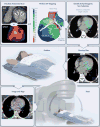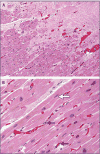Noninvasive Cardiac Radiation for Ablation of Ventricular Tachycardia
- PMID: 29236642
- PMCID: PMC5764179
- DOI: 10.1056/NEJMoa1613773
Noninvasive Cardiac Radiation for Ablation of Ventricular Tachycardia
Abstract
Background: Recent advances have enabled noninvasive mapping of cardiac arrhythmias with electrocardiographic imaging and noninvasive delivery of precise ablative radiation with stereotactic body radiation therapy (SBRT). We combined these techniques to perform catheter-free, electrophysiology-guided, noninvasive cardiac radioablation for ventricular tachycardia.
Methods: We targeted arrhythmogenic scar regions by combining anatomical imaging with noninvasive electrocardiographic imaging during ventricular tachycardia that was induced by means of an implantable cardioverter-defibrillator (ICD). SBRT simulation, planning, and treatments were performed with the use of standard techniques. Patients were treated with a single fraction of 25 Gy while awake. Efficacy was assessed by counting episodes of ventricular tachycardia, as recorded by ICDs. Safety was assessed by means of serial cardiac and thoracic imaging.
Results: From April through November 2015, five patients with high-risk, refractory ventricular tachycardia underwent treatment. The mean noninvasive ablation time was 14 minutes (range, 11 to 18). During the 3 months before treatment, the patients had a combined history of 6577 episodes of ventricular tachycardia. During a 6-week postablation "blanking period" (when arrhythmias may occur owing to postablation inflammation), there were 680 episodes of ventricular tachycardia. After the 6-week blanking period, there were 4 episodes of ventricular tachycardia over the next 46 patient-months, for a reduction from baseline of 99.9%. A reduction in episodes of ventricular tachycardia occurred in all five patients. The mean left ventricular ejection fraction did not decrease with treatment. At 3 months, adjacent lung showed opacities consistent with mild inflammatory changes, which had resolved by 1 year.
Conclusions: In five patients with refractory ventricular tachycardia, noninvasive treatment with electrophysiology-guided cardiac radioablation markedly reduced the burden of ventricular tachycardia. (Funded by Barnes-Jewish Hospital Foundation and others.).
Figures




Comment in
-
Noninvasive Ablation of Ventricular Tachycardia.N Engl J Med. 2017 Dec 14;377(24):2388-2390. doi: 10.1056/NEJMe1713245. N Engl J Med. 2017. PMID: 29236632 No abstract available.
-
Arrhythmias: Noninvasive radioablation for VT.Nat Rev Cardiol. 2018 Mar;15(3):133. doi: 10.1038/nrcardio.2018.5. Epub 2018 Jan 25. Nat Rev Cardiol. 2018. PMID: 29368700 No abstract available.
-
[Case series on SBRT in ventricular tachycardia reveals an impressive therapeutic effect].Strahlenther Onkol. 2018 May;194(5):462-464. doi: 10.1007/s00066-018-1285-3. Strahlenther Onkol. 2018. PMID: 29500550 German. No abstract available.
-
Noninvasive Ablation of Ventricular Tachycardia.N Engl J Med. 2018 Apr 26;378(17):1650. doi: 10.1056/NEJMc1802625. N Engl J Med. 2018. PMID: 29697916 No abstract available.
-
Noninvasive Ablation of Ventricular Tachycardia.N Engl J Med. 2018 Apr 26;378(17):1650-1. doi: 10.1056/NEJMc1802625. N Engl J Med. 2018. PMID: 29697917 No abstract available.
References
-
- Cochet H, Komatsu Y, Sacher F, et al. Integration of merged delayed-enhanced magnetic resonance imaging and multidetector computed tomography for the guidance of ventricular tachycardia ablation: a pilot study. J Cardiovasc Electrophysiol. 2013;24:419–26. - PubMed
-
- Dickfeld T, Tian J, Ahmad G, et al. MRI-guided ventricular tachycardia ablation: integration of late gadolinium-enhanced 3D scar in patients with implantable cardioverter-defibrillators. Circ Arrhythm Electrophysiol. 2011;4:172–84. - PubMed
Publication types
MeSH terms
Grants and funding
LinkOut - more resources
Full Text Sources
Other Literature Sources
Medical
Miscellaneous
